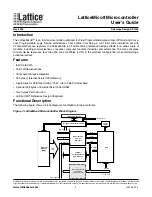
Setting Alarm as Latching or Non-Latching
The alarms can be set as latching or Non-Latching by setting the Dip-
Switch located on lower left corner of the control module. See figure 5.
The dip-switch is labeled as
Relays
with arrow indicating the switch
selection for latching or non-latching. Position 1 of the Dip-switch is for
Low alarm , position 2 is for High alarm and position 3 for High-High
alarm. Position 4 is not used for standard application and is reserved for
custom application or future use.
To set the alarm as latching move the dip-switch up or move the dip
switch down for non-latching alarms.
The dip-switch positions in the diagram below shows Low and High
alarm configured as non-latching and High-High alarm set as latching
RELAYS
LATCHING
NON−LATHING
1 2 3 4
24



































